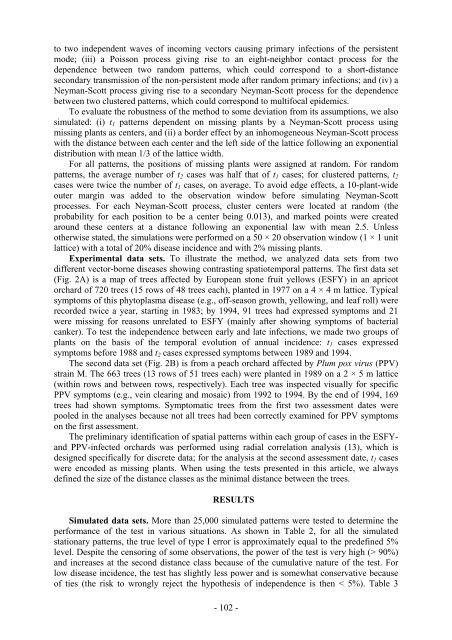Ecole Nationale Supérieure Agronomique de Montpellier ... - CIAM
Ecole Nationale Supérieure Agronomique de Montpellier ... - CIAM
Ecole Nationale Supérieure Agronomique de Montpellier ... - CIAM
Create successful ePaper yourself
Turn your PDF publications into a flip-book with our unique Google optimized e-Paper software.
to two in<strong>de</strong>pen<strong>de</strong>nt waves of incoming vectors causing primary infections of the persistent<br />
mo<strong>de</strong>; (iii) a Poisson process giving rise to an eight-neighbor contact process for the<br />
<strong>de</strong>pen<strong>de</strong>nce between two random patterns, which could correspond to a short-distance<br />
secondary transmission of the non-persistent mo<strong>de</strong> after random primary infections; and (iv) a<br />
Neyman-Scott process giving rise to a secondary Neyman-Scott process for the <strong>de</strong>pen<strong>de</strong>nce<br />
between two clustered patterns, which could correspond to multifocal epi<strong>de</strong>mics.<br />
To evaluate the robustness of the method to some <strong>de</strong>viation from its assumptions, we also<br />
simulated: (i) t1 patterns <strong>de</strong>pen<strong>de</strong>nt on missing plants by a Neyman-Scott process using<br />
missing plants as centers, and (ii) a bor<strong>de</strong>r effect by an inhomogeneous Neyman-Scott process<br />
with the distance between each center and the left si<strong>de</strong> of the lattice following an exponential<br />
distribution with mean 1/3 of the lattice width.<br />
For all patterns, the positions of missing plants were assigned at random. For random<br />
patterns, the average number of t2 cases was half that of t1 cases; for clustered patterns, t2<br />
cases were twice the number of t1 cases, on average. To avoid edge effects, a 10-plant-wi<strong>de</strong><br />
outer margin was ad<strong>de</strong>d to the observation window before simulating Neyman-Scott<br />
processes. For each Neyman-Scott process, cluster centers were located at random (the<br />
probability for each position to be a center being 0.013), and marked points were created<br />
around these centers at a distance following an exponential law with mean 2.5. Unless<br />
otherwise stated, the simulations were performed on a 50 × 20 observation window (1 × 1 unit<br />
lattice) with a total of 20% disease inci<strong>de</strong>nce and with 2% missing plants.<br />
Experimental data sets. To illustrate the method, we analyzed data sets from two<br />
different vector-borne diseases showing contrasting spatiotemporal patterns. The first data set<br />
(Fig. 2A) is a map of trees affected by European stone fruit yellows (ESFY) in an apricot<br />
orchard of 720 trees (15 rows of 48 trees each), planted in 1977 on a 4 × 4 m lattice. Typical<br />
symptoms of this phytoplasma disease (e.g., off-season growth, yellowing, and leaf roll) were<br />
recor<strong>de</strong>d twice a year, starting in 1983; by 1994, 91 trees had expressed symptoms and 21<br />
were missing for reasons unrelated to ESFY (mainly after showing symptoms of bacterial<br />
canker). To test the in<strong>de</strong>pen<strong>de</strong>nce between early and late infections, we ma<strong>de</strong> two groups of<br />
plants on the basis of the temporal evolution of annual inci<strong>de</strong>nce: t1 cases expressed<br />
symptoms before 1988 and t2 cases expressed symptoms between 1989 and 1994.<br />
The second data set (Fig. 2B) is from a peach orchard affected by Plum pox virus (PPV)<br />
strain M. The 663 trees (13 rows of 51 trees each) were planted in 1989 on a 2 × 5 m lattice<br />
(within rows and between rows, respectively). Each tree was inspected visually for specific<br />
PPV symptoms (e.g., vein clearing and mosaic) from 1992 to 1994. By the end of 1994, 169<br />
trees had shown symptoms. Symptomatic trees from the first two assessment dates were<br />
pooled in the analyses because not all trees had been correctly examined for PPV symptoms<br />
on the first assessment.<br />
The preliminary i<strong>de</strong>ntification of spatial patterns within each group of cases in the ESFY-<br />
and PPV-infected orchards was performed using radial correlation analysis (13), which is<br />
<strong>de</strong>signed specifically for discrete data; for the analysis at the second assessment date, t1 cases<br />
were enco<strong>de</strong>d as missing plants. When using the tests presented in this article, we always<br />
<strong>de</strong>fined the size of the distance classes as the minimal distance between the trees.<br />
RESULTS<br />
Simulated data sets. More than 25,000 simulated patterns were tested to <strong>de</strong>termine the<br />
performance of the test in various situations. As shown in Table 2, for all the simulated<br />
stationary patterns, the true level of type I error is approximately equal to the pre<strong>de</strong>fined 5%<br />
level. Despite the censoring of some observations, the power of the test is very high (> 90%)<br />
and increases at the second distance class because of the cumulative nature of the test. For<br />
low disease inci<strong>de</strong>nce, the test has slightly less power and is somewhat conservative because<br />
of ties (the risk to wrongly reject the hypothesis of in<strong>de</strong>pen<strong>de</strong>nce is then < 5%). Table 3<br />
- 102 -



